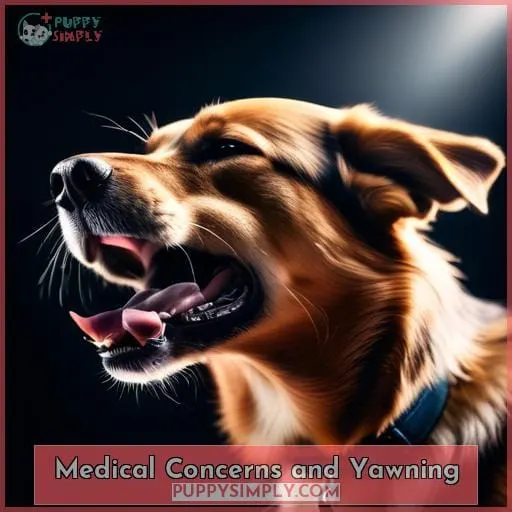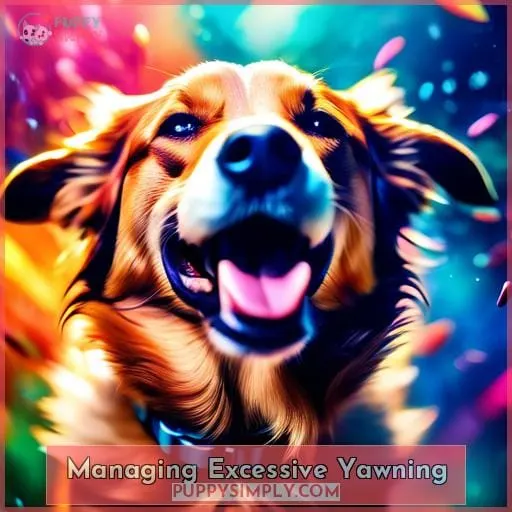This site is supported by our readers. We may earn a commission, at no cost to you, if you purchase through links.
 Ever noticed your dog yawning and wondered what’s behind it?
Ever noticed your dog yawning and wondered what’s behind it?
It’s not just a sign of sleepiness; yawns can signal stress, serve as a communication tool, or even indicate health issues.
As you tune into your furry friend’s cues, you’ll discover a complex language beyond barks and tail wags.
This article unpacks the reasons behind canine yawns, offering insights into their emotional and physical well-being, and helps you respond with empathy and understanding.
Table Of Contents
- Key Takeaways
- Understanding Dog Yawns
- Yawning as Communication
- Yawning in Social Contexts
- Yawning and Dog Emotions
- Medical Concerns and Yawning
- Managing Excessive Yawning
- Frequently Asked Questions (FAQs)
- Can a dog’s breed influence how often or why they yawn?
- Are there specific times of day when dogs are more likely to yawn?
- How does a dog’s age affect their yawning behavior?
- Can training or behavior modification techniques reduce yawning in dogs?
- Are there any specific diseases or health conditions that can cause excessive yawning in dogs?
- Conclusion
Key Takeaways
- Yawning in dogs serves multiple physiological purposes, such as stimulating the nervous system and cooling the brain, similar to the effects of caffeine in humans. It often occurs during transitions between different behavioral states, like waking up, falling asleep, or shifting moods.
- Dogs use yawning as a communication tool, especially in stressful situations. It can serve as a calming signal, indicating the dog’s attempt to relieve stress and avoid conflict. Excessive yawning may be a sign of high anxiety, and understanding these signals can help prevent escalation.
- Yawning in dogs can also be contagious, particularly in response to familiar yawns. This phenomenon, which is believed to have an evolutionary origin, may reflect the dog’s capacity for empathy and its social bonds. It’s a part of the complex social intelligence of dogs.
- The context of yawning can provide insights into a dog’s emotional state. For instance, a relaxed body language and a slow, wide-mouthed yawn may indicate happiness, while excessive yawning accompanied by destructive behavior or loss of appetite may signal boredom, frustration, or an underlying health condition.
Understanding Dog Yawns
When trying to understand why dogs yawn, it’s crucial to consider both physiological reasons and behavioral state transitions.
Yawning in dogs can stimulate their nervous system and help cool down their brain temperature, especially during transitions such as waking up, falling asleep, or moving from a state of anxiety to calmness.
This behavior isn’t only a response to physical needs but also plays a significant role in their emotional and social communication, indicating feelings ranging from stress to contentment.
Physiological Reasons
By stimulating the nervous system, cooling the brain, and marking behavioral state transitions like waking up or falling asleep, yawning serves several physiological functions for dogs.
This involuntary action is akin to a system reboot, providing a jolt to the nervous system akin to the effects of caffeine.
It’s not just about tiredness or boredom; yawning can signify shifts from anxiety to calmness or from inactivity to alertness.
The brain cooling hypothesis suggests that the act of yawning, with its deep inhalation, helps to regulate brain temperature, especially when it rises.
This is crucial, as a stable brain temperature is essential for optimal physiological functioning.
While you watch your dog transition through various states, remember that each yawn could be a complex interplay of brain cooling, nervous system stimulation, and emotional signaling, reflecting their current state of stress, fear, anxiety, or simply the need to shift gears.
Behavioral State Transitions
Yawning in dogs also occurs during behavioral state transitions, like when they’re waking up, falling asleep, shifting from anxiety to calm, or moving from boredom to alertness.
This transitional behavior is thought to help stimulate the nervous system and cool the brain as the dog’s state changes.
Yawning seems to mark shifts between different behavioral states or moods.
Dogs may yawn when transitioning from an anxious emotional state to a more relaxed one.
They also often yawn when going from boredom and inactivity to increased alertness and engagement with their surroundings.
While the exact mechanisms are still being studied, it’s clear that dogs use yawning flexibility during key transitions in their daily lives.
Proper interpretation requires noting the context around yawning episodes to discern the behavioral state shifts.
Yawning as Communication
Here we discuss why dogs yawn as a means of communication.
Yawns can indicate stress and anxiety, serving as pacifying signals to avoid conflict.
They also communicate calm intentions, transmitting emotions to the social group.
Stress and Anxiety Indicators
With excessive yawning, you’re seeing the dog communicate anxiety and tension that needs to be released. This behavior is a clear signal that your furry friend is encountering stress triggers and is trying to cope.
Behavioral cues like ears back and avoidance accompany a stress-induced dog yawn.
Anxiety management may be needed if yawning is frequent and persistent.
Identifying stress triggers can help you create a more comfortable environment.
Coping mechanisms such as yawning can indicate a need for space or a break from overwhelming environmental factors.
Calming and Pacifying Signals
You’ll see dogs yawning to communicate calm in tense situations.
Yawning can act as a pacifying gesture to relieve stress and avoid conflict.
Here’s a quick reference for deciphering yawn signals:
| Signs | Meaning | Response |
|---|---|---|
| Slow, relaxed yawn | Low stress | Stay calm |
| Yawn with whale eye or lip lick | Mild anxiety | Give space |
| Repeated yawning | High anxiety | Remove from situation |
| Yawning while avoiding eye contact | Very nervous | Let dog retreat |
Dogs may yawn repeatedly to self-soothe when facing a perceived threat.
By acknowledging calming signals like yawning, you can help your dog emotionally regulate and prevent escalation.
Proper identification of dog body language promotes peaceful communication.
Yawning in Social Contexts
Yawning is contagious among humans and dogs.
When you yawn, your dog may yawn in response as a sign of empathy and to strengthen your social bond.
This contagious yawning is thought to be a learned behavior that helps create connections.
Contagious Yawning
You’re likely to notice your dog yawning in response to you or other dogs yawning, as this behavior is contagious among dogs and people they know well.
Contagious yawning in dogs likely stems from an evolutionary origin, though the exact mechanisms are still being studied.
Dogs may yawn in response to:
- Your yawn, especially if you two share a close bond
- A littermate’s yawn during playtime
- A neighbor dog’s yawn at the dog park
While the contagious yawn phenomenon has cultural variances, it appears dogs empathize with their human and canine friends through mimicking this behavior.
More research on the neurological correlates in dogs is needed, but it’s clear contagious yawning develops as dogs mature and supports their social nature.
Empathy and Social Bonds
Your dog’s tendency to yawn when you do may be a sign of the strong social bond you share, reflecting their capacity for empathy and connection.
As highly social animals, canines develop empathy through proper socialization, learning to read human emotional cues. This allows them to synchronize behaviors like contagious yawning, responding to your yawns with their own.
Simple bonding activities like playtime, training, petting, and walks strengthen your emotional connection. Tuning into your dog’s unique communication style and responding consistently helps build mutual understanding.
An empathetic human-canine relationship satisfies your dog’s social needs and supports their well-being. Nurturing this loving bond through positive interactions allows your dog’s natural empathy to blossom.
Yawning and Dog Emotions
- You may notice your dog yawning when it’s relaxed and content, with a slow, wide-mouthed yawn and eyes briefly closing – signs of a happy pup.
- Excessive barking, chewing, and pacing could accompany bored yawns, indicating your dog needs more stimulation.
- Pay attention to the context around your dog’s yawning to better understand their emotional state.
Signs of Happiness
Dogs yawn when happy to communicate joy, contentment, and empathy with loved ones.
You’ll see relaxed body language and tail wagging accompany happy yawning.
- Slow, wide-mouthed yawn with eyes closing briefly
- Body relaxed, ears perked, tail wagging
- Often paired with play bows or nibbling/licking owner
Happy yawning in dogs shows a joyful mood and contentment with their people or pack.
Look for a soft mouth stretch, settled posture, and pleasure signals like nibbling or tail wags.
These happiness indicators communicate the dog is at ease and expressing empathy or excitement.
Understanding the context and body language of a yawn allows accurate interpretation of your pup’s emotions.
Signs of Boredom or Frustration
- Your dog’s destructive behavior, such as excessive barking, whining, digging, chewing on furniture or shoes, pacing back and forth, or lack of interest in playtime, can stem from boredom or frustration.
- Providing more stimulating activities can prevent these destructive behaviors and ease boredom.
- Interactive toys, training exercises, and enrichment techniques that incorporate scent, sound, and food puzzles can provide mental stimulation.
- Take your dog on varied walks with new sights and smells to stimulate its senses.
- Regularly rotate toys to maintain novelty and interest.
- Use positive reinforcement to train your dog new behaviors and games, which can also boost mental activity.
- Games that incorporate hiding treats can also boost mental activity.
- By incorporating activities and toys that challenge your dog mentally, you can curb boredom and reduce frustration.
Medical Concerns and Yawning
When continuous or excessive yawning accompanies other concerning symptoms, it’s time to visit the vet.
Potential underlying medical causes include:
- Nausea
- Neurological disorders
- Respiratory disease
- Pain
Look for accompanying:
- Lethargy
- Loss of appetite
- Excessive licking
- Changes in breathing
When to See a Vet
Concern arises when your dog is excessively yawning or showing other worrisome signs along with it.
You’d want to see a vet if excessive yawning occurs while eating or drinking, if there’s lethargy, loss of appetite, or obsessive paw licking.
- Excessive yawning with no obvious trigger
- Lethargy or loss of energy
- Loss of appetite or refusal to eat
An underlying condition could be causing these symptoms.
Schedule a veterinary exam for proper diagnosis and treatment options.
Preventive care, wellness exams, diagnostic tests, and veterinary consultations ensure your dog’s health and wellbeing.
Addressing excessive yawning right away prevents suffering and supports their best possible quality of life.
Potential Medical Causes
Excessive panting in your dog could be indicative of underlying health issues, ranging from allergies to more serious conditions like heart disease or respiratory problems.
It’s crucial to seek a veterinary assessment if you notice this behavior.
Diagnostic tests can help pinpoint the cause, leading to effective treatment options.
Sometimes, behavioral modification or lifestyle adjustments may be recommended.
Understanding the potential medical causes of excessive panting can help ensure your furry friend stays happy and healthy.
So, keep an eye out for changes and don’t hesitate to consult your vet.
Managing Excessive Yawning
When managing excessive yawning in dogs, it’s crucial to identify and mitigate stressors while ensuring a secure environment for your pet.
Avoiding situations that overwhelm or cause anxiety, such as loud noises or crowded places, can help reduce stress-induced yawning.
Creating a safe and calm space where your dog can retreat and relax is equally important, offering them a sanctuary from potential stress.
This approach, grounded in understanding canine behavior and stress management techniques, aims to support your dog’s well-being and reduce excessive yawning linked to stress or discomfort.
Avoiding Stressful Situations
To seamlessly transition from the potential health implications of excessive yawning, it’s important to recognize that many of these instances can be mitigated by proactively managing your dog’s environment to minimize stress.
Stress avoidance is key, and this can be achieved through:
- Environmental enrichment
- Providing a safe space
- Engaging in relaxation techniques
Behavioral modification strategies can help your dog cope with stressors, while anxiety management can further alleviate stress-induced yawning.
Creating a Safe Space
After minimizing stressors in your dog’s environment, you’ll want to create a safe space where they can retreat and feel secure when they need to unwind or escape overwhelming situations.
Designate a tranquil retreat, a stress-free zone that serves as a safe haven. This comfort zone should be quiet, cozy, and accessible, offering your dog a sense of control.
In these anxiety-free environments, dogs can decompress, reducing the need for excessive yawning as a stress response.
Soft bedding, familiar toys, and gentle music can enhance the calming effect of these comfort zones.
Frequently Asked Questions (FAQs)
Can a dog’s breed influence how often or why they yawn?
While the reasons for yawning in dogs are multifaceted and not fully understood, there’s no clear evidence suggesting a dog’s breed directly influences how often or why they yawn.
Yawning in dogs can be a sign of various states, including stress, excitement, or boredom, but these behaviors aren’t breed-specific.
Are there specific times of day when dogs are more likely to yawn?
Dogs often yawn during transitions:
- Like waking up
- Before sleeping
Dogs may yawn more when stressed:
- Such as at the vet
- During a thunderstorm
How does a dog’s age affect their yawning behavior?
As dogs mature, they’re more prone to partake in the peculiar practice of contagious yawning.
This phenomenon parallels the progression in people.
Can training or behavior modification techniques reduce yawning in dogs?
Yes, training and behavior modification techniques can effectively reduce yawning in dogs, especially if it’s linked to stress or anxiety.
Techniques like desensitization and counterconditioning can change a dog’s emotional response to stressors, making them feel more relaxed and reducing stress-induced yawning.
Positive reinforcement can also help build trust and encourage calm behavior.
However, it’s important to approach these methods with patience and consistency for the best results.
Are there any specific diseases or health conditions that can cause excessive yawning in dogs?
Yawning yips and yawning yawns,
Your dog’s drowsy display might delve deeper than mere sleepiness.
Excessive yawning in dogs can signal serious health scenarios:
- Dental distress
- Digestive dilemmas
- Heart hardships
Always alert a veterinarian if yawning yawns alongside symptoms like lethargy or loss of appetite.
Conclusion
Chances are, you’ve caught your dog yawning and wondered what it means.
Far from a simple sign of sleepiness, a yawn can be a window into your dog’s emotional and physical state.
Whether it’s a sign of stress, a communication tool, or even a health indicator, understanding why dogs yawn can deepen the bond between you and your furry friend.
By recognizing the various reasons behind a yawn, from stress relief to social bonding, you’re better equipped to provide the care and comfort your dog needs.
Ultimately, every yawn is a chance to connect and ensure your dog’s well-being.












